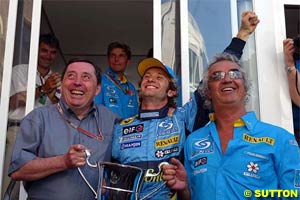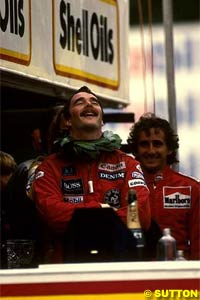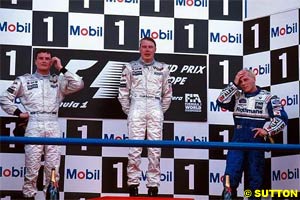
Atlas F1 Magazine Writer
Who else has claimed his first pole and race win on the same weekend? Who is the most likely polesitter at the Nurburgring, and who claimed his maiden win there? Marcel Schot brings the answers and more anecdotes on the European Grand Prix
The battle for pole position at the European Grand Prix is traditionally an unpredictable one. Since 1983 no driver has been on pole for two consecutive European Grands Prix, with the last seven editions of the race having seen seven different polesitters. In fact, in thirteen races, only Michael Schumacher and David Coulthard have claimed pole twice, the German in 1994 and 2001 and the Scotsman in 1995 and 2000.
Three of a kind
Through the years three drivers have scored their first victory in the European Grand Prix. In 1985 it was Nigel Mansell for Williams at Brands Hatch, in 1996 Jacques Villeneuve for Williams at the Nurburgring and a year later Mika Hakkinen for McLaren in Jerez. As so often happens, the similar results came together in very different ways.
For Mansell it was a strange weekend. After a season with few highlights and lots of mediocrities, the results on Friday predicted yet more mediocrity. While his teammate Keke Rosberg was strong in third, barely beaten by Nelson Piquet and a full second behind an impossibly fast Ayrton Senna, Mansell was down in a rather disappointing seventh place. In the second session, on Saturday, Ayrton Senna went a notch faster just as the rest of the field found where his Friday speed had come from. This meant that even though Nigel Mansell was only four hundreds off Senna's Friday time, it was only enough for third on the grid.
While third position on the grid gave Mansell hope, the warm-up on Sunday morning didn't. 2.4 seconds slower than Nelson Piquet was quite alarming, as was being over a second slower than the other Williams. When the race came a great start by Mansell put him side by side with Ayrton Senna for the lead into the first corner. Unfortunately, both cars went wide and while Senna held onto the lead, Mansell dropped to fourth behind Rosberg and Piquet. Even though Mansell lost some ground to the other three, he suddenly found himself in second place after seven laps, when Rosberg saw an overtaking attempt on Senna end in a spin, blocking Piquet as the Brabham driver tried to avoid the Finn.
By the time Rosberg got out of the way of the battle for the lead, Mansell had gained a five second lead. However, even with Rosberg out of the way Senna was not able to keep the pace of Mansell, and lap after lap the Briton move further ahead. In the first two thirds of the race the Williams driver built a comfortable lead of 25 seconds, after which he eased off, securing his first victory.
When Jacques Villeneuve won his first race, the situation was a lot different. While Mansell had had years of experience, Villeneuve had just started his first season and the European Grand Prix was just his fourth race. The young Canadian was much hyped, and so far was handling things well with two second places and a pole already in his first three races. On the Friday the Williams driver was in the midfield as usual; only at Albert Park, a track that was new to all drivers, he had been on the pace right away, while at the other tracks he needed his first day to learn the track.
However, when qualifying time came, Villeneuve was among the frontrunners. While his teammate Damon Hill was seven tenths faster, Villeneuve was able to look back at a great qualifying session, which saw him claim second place on the grid. Michael Schumacher in the Ferrari was a further half second back in third, and thus things looked very good for the Williams team indeed.
When the lights went out on Sunday, Villeneuve was in fact the only driver from the first two rows with a decent start, and the Canadian went into the lead right away. He was followed by David Coulthard, who had made a brilliant start from sixth, and Rubens Barrichello in the Jordan. Behind them followed Schumacher and Hill, while Jean Alesi messed up his start, dropping from fourth to thirteenth.
Having Coulthard in second soon proved to be in the advantage of Villeneuve. The McLaren was simply no match for the Williams, yet fast enough to be difficult to overtake. So while Barrichello, Schumacher and Hill tried hard to find a way past the McLaren, Villeneuve worked on building a solid lead. After ten laps the Canadian was some seven seconds ahead of Coulthard. The Canadian continued increasing his lead until the first pitstops, by which time he was 13 seconds ahead.
Unfortunately for Villeneuve, the period between the first and second pitstop really saw Michael Schumacher in a league of his own. Bit by bit the Ferrari driver got closer to the leader. When the German stopped for the second time, he was right on Villeneuve's tail. The pitstop times for both drivers were nearly identical, but with Villeneuve stopping two laps later, the Canadian was once again able to create a small gap.
A year later the European Grand Prix was the scene of the championship deciding final race of the season. The race would be a classic for both good and bad reasons. Things started with qualifying. Jacques Villeneuve set an early pole time of 1:21.072, which was exactly matched by Michael Schumacher halfway into the session. Near the end of the session, Heinz Harald Frentzen in the other Williams amazingly did the same, making it three cars with exactly the same time.
As the order of setting the times now came into play, it was Villeneuve on pole, championship rival Schumacher next to him and Frentzen on row two together with Damon Hill, who was just six hundreds slower than the trio in the Arrows. Completely unnoticed behind all this excitement were the McLarens of Mika Hakkinen and David Coulthard on the third row.
When the race got underway Villeneuve dropped to third as Schumacher shot off into the lead with Frentzen following. Hill had a bad start, which sent both McLarens ahead of the reigning champion. By lap eight Frentzen allowed Villeneuve into second, giving the Canadian the task of making up the four second gap to his rival. Meanwhile, Mika Hakkinen was just over a second adrift of Frentzen and driving a solid race, with Coulthard nearly three seconds behind him and Hill another two back.
Positions remained unchanged until the first series of pitstops, but it was clear that nobody could match Schumacher and Villeneuve. While the Canadian has difficulty in keeping the pace of the Ferrari driver, the rest fell behind quickly. Frentzen, Hakkinen and Coulthard formed their own train nearly twenty seconds behind the leader.
During that first set of pitstops both McLarens made their way past Frentzen, with Coulthard ending up the big winner as he managed to come back out ahead of his teammate. At the front Villeneuve managed to close the gap to just a second by stopping a lap later than Schumacher. Halfway through the race Schumacher remained in the lead, with Villeneuve now under three seconds behind him. 15 seconds behind them Coulthard was third, with Hakkinen less than a second behind him, followed by Frentzen and the second Ferrari of Eddie Irvine.
Then on lap 47, just as the leaders had pitted for the second time and the rest of the field was busy doing the same, the incident happened that gave this race a black shadow in the history books, as well as playing a great part in the eventual outcome. Going into Dry Sack corner, Villeneuve was on Schumacher's tail and saw an overtaking opportunity. The Williams driver went for the inside, but in an instinctive move Schumacher steered to the inside in a final attempt to block the Canadian. The two collided and Schumacher shot off into the gravel on the other side, retiring and handing Villeneuve the championship.
This gave Coulthard second place and Hakkinen third. As the final stage of the race unfolded, the Williams of Villeneuve slowed down considerably and the cars behind him were able to catch up. As the chequered flag came nearer, it became all the more obvious that Williams and McLaren had made a deal whereby McLaren were given the race win without Villeneuve having to battle and risk retirement. Within the McLaren team itself, it was apparently decided that Hakkinen deserved his first victory after having suffered from a lot of bad luck throughout the season, as Coulthard blatantly moved over three laps from the end. In the final lap Villeneuve all but parked his car to give Hakkinen his win and, as Coulthard also slipped through, it became a one-two for McLaren.
In the sixth race, the string was broken. After five consecutive victories for Michael Schumacher and eight for Ferrari, it was finally a different face on top of the podium. In his 117th start, Jarno Trulli finally won his first race. The Italian was just the twelfth driver in history and the third since 1960 to achieve both his first pole and first victory in the same Grand Prix. The only other drivers to achieve this since 1960 were Nelson Piquet in the 1980 USA-West Grand Prix and Ayrton Senna in the 1985 Portuguese Grand Prix.
 Trulli's win also extends his string of consecutive point finishes to eight races, the longest streak by an Italian since Elio de Angelis did the same in 1984 and the beginning of 1985 at Lotus. Even though Schumacher's streak of point finishes and victories was ended by the German's retirement, his streak of leading races continues. The World Champion has now led in six consecutive races, his fifth longest streak. However, this is a record that's unlikely to be beaten, even by Schumacher. Between the 1968 American Grand Prix and the 1970 Belgian Grand Prix, Jackie Stewart led no less than 17 consecutive races.
Trulli's win also extends his string of consecutive point finishes to eight races, the longest streak by an Italian since Elio de Angelis did the same in 1984 and the beginning of 1985 at Lotus. Even though Schumacher's streak of point finishes and victories was ended by the German's retirement, his streak of leading races continues. The World Champion has now led in six consecutive races, his fifth longest streak. However, this is a record that's unlikely to be beaten, even by Schumacher. Between the 1968 American Grand Prix and the 1970 Belgian Grand Prix, Jackie Stewart led no less than 17 consecutive races.
 While Piquet was out of the race on the spot, Rosberg could continue after a long pitstop. This then played a vital role as the Finn returned to the track just ahead of the leaders, Senna and Mansell. The nearly lapped Williams driver then did a nice job in holding up Senna and Nigel Mansell was able to catch up with the Lotus. When the three cars arrived in Surtees corner Senna momentarily had to lift to avoid Rosberg, giving Mansell the chance to dive down the inside. Rosberg then gave way for his teammate, but slammed the door on Ayrton Senna. The Finn then managed to stay ahead of Senna for more than a full lap, much to the anger of the Brazilian.
While Piquet was out of the race on the spot, Rosberg could continue after a long pitstop. This then played a vital role as the Finn returned to the track just ahead of the leaders, Senna and Mansell. The nearly lapped Williams driver then did a nice job in holding up Senna and Nigel Mansell was able to catch up with the Lotus. When the three cars arrived in Surtees corner Senna momentarily had to lift to avoid Rosberg, giving Mansell the chance to dive down the inside. Rosberg then gave way for his teammate, but slammed the door on Ayrton Senna. The Finn then managed to stay ahead of Senna for more than a full lap, much to the anger of the Brazilian.
 Schumacher continued to push, and within five laps he had made up the lost ground and was right back under the Williams' rear wing. Even when the pair was glued together for the remaining 15 laps, Schumacher never had a realistic overtaking opportunity due to the lack of top speed of his Ferrari. Villeneuve, used to close racing in Indy Cars, kept his head cool and steered the car to victory in just his fourth Formula One race.
Schumacher continued to push, and within five laps he had made up the lost ground and was right back under the Williams' rear wing. Even when the pair was glued together for the remaining 15 laps, Schumacher never had a realistic overtaking opportunity due to the lack of top speed of his Ferrari. Villeneuve, used to close racing in Indy Cars, kept his head cool and steered the car to victory in just his fourth Formula One race.
|
Contact the Author Contact the Editor |
Please Contact Us for permission to republish this or any other material from Atlas F1.
|
Volume 10, Issue 21
Atlas F1 Exclusive
Interview with Patrick Head
Bjorn Wirdheim: Going Places
Ann Bradshaw: Point of View
2004 Monaco GP Review
2004 Monaco GP Review
Technical Review: Monaco
Tunnel Vision
2004 European GP Preview
2004 European GP Preview
European GP Facts & Stats
Stats Center
Qualifying Differentials
SuperStats
Charts Center
Columns
The F1 Insider
Season Strokes
On the Road
Elsewhere in Racing
The Weekly Grapevine
> Homepage |